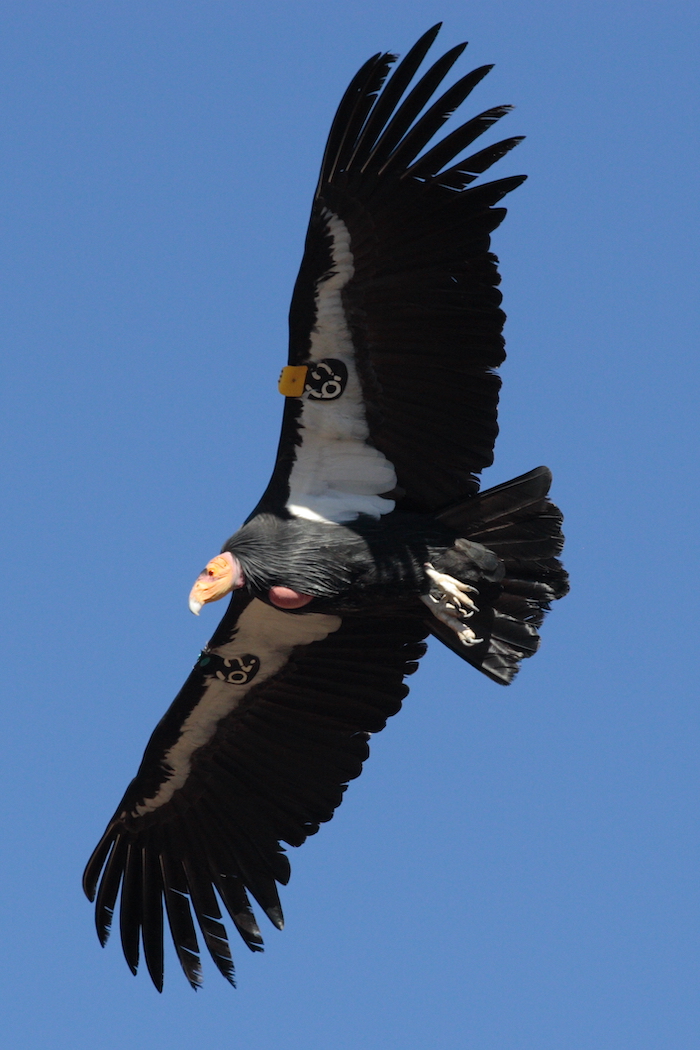
This condor soaring in Zion National Park shows its white wing wedges, its bald head that sheds bacteria, and the number tags that allow the condor recovery team to track their releases.
For some people, there is a hole in the sky, a blank spot. The condor is missing.
When humans first crossed the Bering Strait into North America condors soared widely across the continent. Their fossils have been found along all the coastal regions of the contiguous US. But the megafauna–mastodons, ground sloths, and other giants–began to die off, and the scavengers that likely ate their carcasses also declined. By the time Lewis and Clark sighted condors in the Columbia River gorge in 1805, it appears they lived only from British Columbia down to Baja California. It is likely that marine mammals as well as elk fed these birds. In any case, as pioneers and settlers moved into the area, they dwindled, their range further shrank, and they became known as “California” condors.
Condors are huge. Their wingspan is routinely over nine feet. Their flight habits resemble those of their little cousins, turkey vultures. On spread wings they ride warm columns of air to thousands of feet up. Then they can float for miles and miles, seeking the dead animals below that will make their meals, all without once flapping their airplane wings after the initial labor of getting airborne.
Condors have keen eyesight, but they lack the sense of smell that turkey vultures have. So sometimes the smaller vultures can find a dinner carcass first. But if the hide is too thick, they cannot cut through it, and must await the condor, whose size and power allows it to rip through the tougher hides. Once a carcass is opened, first golden eagles may dine, then condors, and then the other scavengers.
Over the last couple centuries shooting, poisoning, egg-collecting, and harassment brought the number of California condors down to twenty-seven. In a desperate attempt to save them, the US Fish & Wildlife Service captured the last wild condors in 1987 and launched a breeding program that sought to bring them back by protecting them, avoiding inbreeding, and promoting egg-laying.
Condors reproduce slowly. They lay just one egg in a nest, and after two months of incubation the hatchling depends on its parents for at least another six months. With this long fledging period, the parents usually nest only every other year. The captive breeding team successfully doubled population growth by removing the first egg quickly, to be raised by hand. The mother bird then was likely to lay a second egg, which the condors themselves incubated and raised.
The captive breeding program has been successful, so that now three hundred twenty-four condors are flying free in Arizona and Southern California. And now comes the North State’s turn.
In 2008 the Yurok tribe, centered along the lower Klamath River, began the work of returning the condor, prey-go-neesh by its older name, to North State skies. They collaborated with many groups and agencies, including US Fish and Wildlife, National and State Parks, and the Oregon, Los Angeles, and San Diego Zoos. They evaluated essential elements of habitat. They found that marine and terrestrial wildlife carcasses will likely be available to North State condors. They found that DDT and its related chemicals, which are still produced in South America, are at non-catastrophic levels this far north. They found that lead from ingested bullets could be fatal, and were working with hunters to replace lead bullets when the state banned lead bullets in 2019.
The tribe has also worked to develop their own capacity to acclimate new releases, monitor the birds, and treat them for problems such as lead poisoning.
The birds to be released in the North State will be young, just two years old. They can begin to breed at age seven or eight. The condor lifespan can be upwards of sixty years. The plan is to release six birds each year for twenty years.
If there is a hole in our sky, the condors will begin to fill it this spring. The first two birds are slated to be released this April or May. Look skyward for updates!

No comments yet.